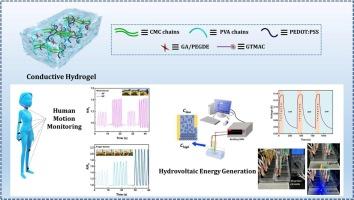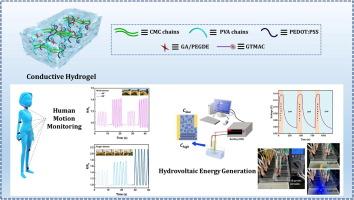用于多功能可穿戴传感器和渗透发电机的极低电滞水凝胶
IF 13.2
1区 工程技术
Q1 ENGINEERING, CHEMICAL
引用次数: 0
摘要
在这项研究中,开发了一种由羧甲基纤维素(CMC)、聚乙烯醇(PVA)和聚(3,4-乙烯二氧噻吩)聚苯乙烯磺酸盐(PEDOT:PSS)组成的高拉伸导电水凝胶膜,用于可穿戴传感器、基于机器学习的活动识别和光伏发电。优化后的水凝胶抗拉强度为0.391 MPa,断裂伸长率为303.8 %,韧性为0.525 MJ/m3,电导率为2.04 S/m,应变为50 %时的电迟滞率为0.101 %。测量因子为1.034,水凝胶准确检测到人体运动,使用机器学习对运动进行分类,分类准确率达到100% %。在水电应用中,16片串联的薄膜产生2.01 V,为发光二极管灯供电。这些结果突出了CMC-PVA-PEDOT:基于pss的水凝胶在下一代可穿戴电子产品和可持续能源系统中的潜力。本文章由计算机程序翻译,如有差异,请以英文原文为准。


Extremely-low electrical-hysteresis hydrogels for multifunctional wearable sensors and osmotic power generators
In this study, a highly stretchable and conductive hydrogel film composed of carboxymethyl cellulose (CMC), polyvinyl alcohol (PVA), and poly(3,4-ethylenedioxythiophene):poly(styrenesulfonate) (PEDOT:PSS) was developed for application in wearable sensors, machine learning-based activity recognition, and hydrovoltaic energy generation. The optimized hydrogel exhibited a tensile strength of 0.391 MPa, an elongation at break of 303.8 %, a toughness of 0.525 MJ/m3, a conductivity of 2.04 S/m, and a low electrical hysteresis of 0.101 % at 50 % strain. With a gauge factor of 1.034, the hydrogel accurately detected human motions and achieved 100 % classification accuracy in classifying movements using machine learning. In hydrovoltaic applications, 16 films connected in series generated 2.01 V, powering a light-emitting diode lamp. These results highlight the potential of the CMC-PVA-PEDOT:PSS-based hydrogel for next-generation wearable electronics and sustainable energy systems.
求助全文
通过发布文献求助,成功后即可免费获取论文全文。
去求助
来源期刊

Chemical Engineering Journal
工程技术-工程:化工
CiteScore
21.70
自引率
9.30%
发文量
6781
审稿时长
2.4 months
期刊介绍:
The Chemical Engineering Journal is an international research journal that invites contributions of original and novel fundamental research. It aims to provide an international platform for presenting original fundamental research, interpretative reviews, and discussions on new developments in chemical engineering. The journal welcomes papers that describe novel theory and its practical application, as well as those that demonstrate the transfer of techniques from other disciplines. It also welcomes reports on carefully conducted experimental work that is soundly interpreted. The main focus of the journal is on original and rigorous research results that have broad significance. The Catalysis section within the Chemical Engineering Journal focuses specifically on Experimental and Theoretical studies in the fields of heterogeneous catalysis, molecular catalysis, and biocatalysis. These studies have industrial impact on various sectors such as chemicals, energy, materials, foods, healthcare, and environmental protection.
 求助内容:
求助内容: 应助结果提醒方式:
应助结果提醒方式:


